Bay CrossingsCuisine
 Chaya
Brasserie Filet Mignon
Chaya
Brasserie Filet Mignon
By Mary Swift-Swan
Thinking of a menu for June brings to mind
many things. There are graduations, Father’s Day, the
longest day of the year officially starting summer, and many
weddings and anniversaries to celebrate. The goal was to
find a menu that was simple, yet elegant, as well as
something special that men would really enjoy. Bay Crossings
was invited to visit the kitchen of Chaya Brasserie to
observe Chef Tachibe’s recipe for a dish that could work for
any of those occasions.
The Chaya Brasserie in San Francisco is
one of three Chaya restaurants in California. The original
Chaya is located in Japan and still in operation, which is
stunning since it is 360 years old. Many do not realize that
connection because the original Hikage Chaya is known for its
traditional Japanese cooking. The Chaya owners decided to
create new restaurants, the first of which mimicked the
French style. Chaya means “teahouse” in Japanese. Brasserie
is French. The intent was to open restaurants that are a
French Asian meeting. All lead chefs are Japanese,
classically trained in French cooking. There are several Chaya
restaurants in Japan including La Maree’ de Chaya and now a Macrobiotic Chaya among a whole
group of restaurants.
 One
of the owners came to California about 25 years ago and
opened La Petite Chaya. San Francisco’s Chaya Brasserie
owner and executive chef, Shigefumi Tachibe, was the notable
young executive chef who came from Japan with the owner.
Chef Tachibe started with a classic Chaya French menu, but
quickly realized traditional French was too heavy for the
warmer Los Angeles climate. He cut the sauces to lighten
them with what he knew best, Asian ingredients. La Petite
Chaya is credited as the first Fusion restaurant.
One
of the owners came to California about 25 years ago and
opened La Petite Chaya. San Francisco’s Chaya Brasserie
owner and executive chef, Shigefumi Tachibe, was the notable
young executive chef who came from Japan with the owner.
Chef Tachibe started with a classic Chaya French menu, but
quickly realized traditional French was too heavy for the
warmer Los Angeles climate. He cut the sauces to lighten
them with what he knew best, Asian ingredients. La Petite
Chaya is credited as the first Fusion restaurant.
At Chaya Brasserie in San Francisco,
Tachibe has enjoyed working with the amazing varieties of
locally fresh quality ingredients including seafood, and
vegetables.
Over the five years Chaya has been located at 132
Embarcadero, they have developed new menu options unique to
San Francisco using these wonderful ingredients. The San
Francisco menu also has favorites from other California
Chaya Brasserie restaurants. Chaya Brasserieis is also known
for their attention to customers and classic quality
service.
Chaya Filet Mignon
4 7oz. Neiman Ranch Filet Mignon
4 strips Bacon
6 Tbs. Safflower oil
4 Tbs. Unsalted butter (add more if needed )
Use coarse salt and fresh ground black pepper on
each side of the filets.
Full Meal Assembly
4 1.5oz. Slices of foie gras (fresh duck liver)
1/4 cup Chicken stock
1/4 cup Brandy or Marsala
Use coarse salt and fresh ground black pepper on
each side.
4 Soba crepes
4 cups Freshly washed spinach, steamed
1 clove Pressed garlic
Black Truffle Red Wine Sauce (for 4 servings)
Sprig of Italian parsley to garnish |
Filet Mignon Chaya style is a very popular
dish. The first rule in cooking a special meal is to
start with the best and freshest ingredients available.
Frequent visits to a farmers’ market can definitely help.
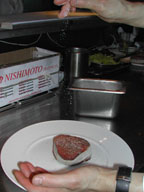 Wrap
each filet with a bacon strip. Sprinkle salt and pepper over
both sides. Heat a pan and add the safflower oil, 1 Tbs. per
filet. Get the pan hot, then place the filet on its edge.
Rotate until the bacon is browned.
Wrap
each filet with a bacon strip. Sprinkle salt and pepper over
both sides. Heat a pan and add the safflower oil, 1 Tbs. per
filet. Get the pan hot, then place the filet on its edge.
Rotate until the bacon is browned.
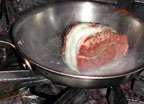 Bacon
is used just for flavoring. Next, pour off the bacon grease
and put in a pat of butter to brown the filet. Brown both
top and bottom adding more butter if needed, about 2 min.
per side to fully sear, creating a glazed surface. Remove
the bacon from the filet.
Bacon
is used just for flavoring. Next, pour off the bacon grease
and put in a pat of butter to brown the filet. Brown both
top and bottom adding more butter if needed, about 2 min.
per side to fully sear, creating a glazed surface. Remove
the bacon from the filet.
 Place
the filet in a clean metal pan and then in a hot oven (450
degree) for approximately 3 minutes. Turn it over and return
to the oven for another 3 minutes. For a 1-3/4” to 2” thick
filet, these times make a perfect medium rare filet that is
warm all the way through yet dark pink in the middle. For
rare (cold in the middle), medium (very warm and pale pink
in the middle), or well done (hot and grey in the middle),
add or subtract approximately 2 minutes per adjustment away
from Medium Rare. To avoid piercing the meat, lightly press
the center of the filet with a freshly washed index finger
tip. If rare, the meat will depress easily, and the meat is
slow to return to shape. If medium rare, the finger will
depresses less, the meat feels warmer under the fingertip
and though slow, it does return to shape. For medium, the
depression is shallow and it springs back rather quickly. If
well done, it does not depress far at all and springs back
to shape immediately. Putting a thermometer in the meat or
poking with a fork to check juice color drains the moisture
out of the meat making it tough to chew.
Place
the filet in a clean metal pan and then in a hot oven (450
degree) for approximately 3 minutes. Turn it over and return
to the oven for another 3 minutes. For a 1-3/4” to 2” thick
filet, these times make a perfect medium rare filet that is
warm all the way through yet dark pink in the middle. For
rare (cold in the middle), medium (very warm and pale pink
in the middle), or well done (hot and grey in the middle),
add or subtract approximately 2 minutes per adjustment away
from Medium Rare. To avoid piercing the meat, lightly press
the center of the filet with a freshly washed index finger
tip. If rare, the meat will depress easily, and the meat is
slow to return to shape. If medium rare, the finger will
depresses less, the meat feels warmer under the fingertip
and though slow, it does return to shape. For medium, the
depression is shallow and it springs back rather quickly. If
well done, it does not depress far at all and springs back
to shape immediately. Putting a thermometer in the meat or
poking with a fork to check juice color drains the moisture
out of the meat making it tough to chew.
While the filets are being finished in the
oven, the potato-stuffed soba crepes are cut in half, then
quickly grilled with a Tbs. of safflower oil.
Steam the fresh spinach. Heat 1 Tbs. of
safflower oil in a pan and add 1 clove of garlic pressed and
cut. Steam spinach until it turns bright green. Move to the
sauté pan and quickly sauté in hot oil and garlic. Remove
from heat when turns slightly dark green.
 Arrange
the sautéed spinach in the middle of the plate. Place the
grilled soba potato-stuffed crepes across the top of the
spinach.
Arrange
the sautéed spinach in the middle of the plate. Place the
grilled soba potato-stuffed crepes across the top of the
spinach.
After the filets are finished cooking in
the oven, they are set on a rack to rest to stop cooking and
cool.
Soba Crepes:(4)
1 egg
10 gram butter
1/4 cup milk
1/4 cup water
1/4 cup buckwheat flour
1/4 cup cake flour
pinch of salt
Potato stuffing for crepes:
16 oz. shredded Yukon potato
1 cup milk
1 cup cream
1 rosemary stalk
salt & pepper to taste |
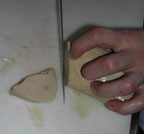 Cut
a slice of fresh foie gras. Salt and pepper both sides. In
the pan where the filets were seared, wipe with oil then
heat til very hot. Add the chicken broth. As soon as it
boils and begins to steam, add the foie gras. Move the pan
on the fire quickly to keep it from burning. Turn it over
and do the same thing. As the last of the chicken broth
boils out, add brandy and light to flambe.
Cut
a slice of fresh foie gras. Salt and pepper both sides. In
the pan where the filets were seared, wipe with oil then
heat til very hot. Add the chicken broth. As soon as it
boils and begins to steam, add the foie gras. Move the pan
on the fire quickly to keep it from burning. Turn it over
and do the same thing. As the last of the chicken broth
boils out, add brandy and light to flambe.
 To
assemble each serving, place the filet on top of the soba
potato crepes. Place the foie gras on top of the filet and
pour a bit of the remaining juice from cooking the foie gras
over each one.
To
assemble each serving, place the filet on top of the soba
potato crepes. Place the foie gras on top of the filet and
pour a bit of the remaining juice from cooking the foie gras
over each one.
Put the pan the filets were in on the
stove, over medium heat. Add 1 Tbs. of truffle oil to loosen
the fond. (A glaze of meat left on the bottom of the pan.)
Next, ladle in the Black Truffle Red Wine Sauce. Heat the
sauce, mixing in the fond, then ladle approximatly 1/4 cup
over the filet and serve.
Serving suggestions to be made ahead. They
can be made as early as the day before.
Black Truffle Red Wine
Sauce:
1 cup Port wine
1 cup Madeira
finely chopped onions, carrots, celery |
Combine above ingredients—should have the
consistency of pancake batter. Pour onto a Teflon pan with
at least 3” separating them to allow for spread. Bake in the
Teflon pan, under medium heat, for 30
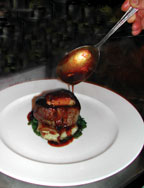 seconds—remove then
allow to cool Combine ingredients in a casserole dish. Bake
for 20 minutes at 400 degrees. Let cool. Layer small amount
of potato stuffing into crepes, heat for 8 minutes at 400
degrees.
seconds—remove then
allow to cool Combine ingredients in a casserole dish. Bake
for 20 minutes at 400 degrees. Let cool. Layer small amount
of potato stuffing into crepes, heat for 8 minutes at 400
degrees.
Reduce
above ingredients on low flame for 1 hour or reduce to 1/5.
Add 2 cups veal stock along with 1 teaspoon black truffle
shavings. Reduce 15 minutes on low flame. Due to the long
reduction time, it is best to make it in advance.
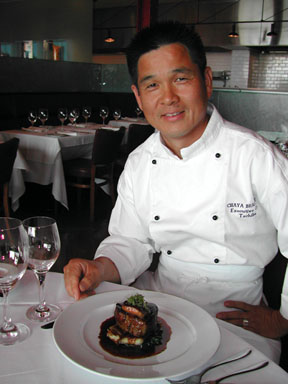 Executive
Chef and part Owner of the three Chaya California
restaurants is Shigefumi Tachibe, known by staff and friends
as Tachibe. Tachibe is an exceptionally talented chef and
inventor by inspiration and necessity. He has created whole
new ways of thinking about food that have been embraced
worldwide. His first major contribution to the world of
cooking was Fusion Cooking when he was the Executive Chef at
La Petite Chaya. La Petite Chaya is known the world over as
the place where Fusion Cooking began, but few know that the
inspiration and creative effort that made it work was by
Chef Tachibe. Chaya Brasserie in West Hollywood eventually
replaced La Petite Chaya. Chaya Venice opened in Venice Beach near Santa Monica.
Tachibe again was
challenged to make seafood adapt to the climate working with Chaya Brasserie’s trademark of traditional French methods
and presentations. Chaya Brasserie in Venice Beach is
credited with inventing the food style now known as Pacific
Rim Seafood. Tachibe is at it again, this time working with
the wonderful bounty of the ocean and valleys of Northern
California that surround their San Francisco Bay location on
The Embarcadero, just a block east of the Ferry Building. He
is developing new menu items using Neiman Ranch beef, fresh
fish, and vegetables from the area. New items are specials
on the menu and something to watch for. Of Tachibe it is
said that he is the most famous unknown chef, because he is
shy and is not often interviewed.
Executive
Chef and part Owner of the three Chaya California
restaurants is Shigefumi Tachibe, known by staff and friends
as Tachibe. Tachibe is an exceptionally talented chef and
inventor by inspiration and necessity. He has created whole
new ways of thinking about food that have been embraced
worldwide. His first major contribution to the world of
cooking was Fusion Cooking when he was the Executive Chef at
La Petite Chaya. La Petite Chaya is known the world over as
the place where Fusion Cooking began, but few know that the
inspiration and creative effort that made it work was by
Chef Tachibe. Chaya Brasserie in West Hollywood eventually
replaced La Petite Chaya. Chaya Venice opened in Venice Beach near Santa Monica.
Tachibe again was
challenged to make seafood adapt to the climate working with Chaya Brasserie’s trademark of traditional French methods
and presentations. Chaya Brasserie in Venice Beach is
credited with inventing the food style now known as Pacific
Rim Seafood. Tachibe is at it again, this time working with
the wonderful bounty of the ocean and valleys of Northern
California that surround their San Francisco Bay location on
The Embarcadero, just a block east of the Ferry Building. He
is developing new menu items using Neiman Ranch beef, fresh
fish, and vegetables from the area. New items are specials
on the menu and something to watch for. Of Tachibe it is
said that he is the most famous unknown chef, because he is
shy and is not often interviewed.
Tachibe began cooking at 15 years old. “I
was poor. I used to be always hungry. Someone said, ‘If you
become a chef you can always eat.’ So I got a job in a
restaurant and learned to cook.” Tachibe was one of three
children, with a sister and brother. The first restaurant he
worked in was in South Japan, joining Chaya at 21. He went
to a culinary school in Japan, for one year. “They taught a
mix of styles: Japanese, Chinese, French, Italian, but I
chose French.” When asked why. “It’s cool!” he laughed. “In
California, there are just two seasons, winter and summer.
In long periods of warm weather, people don’t want heavy
cream and butter, so I add things from the Japanese style
with less butter, a bit of soy, and other techniques to
lighten the food.” Tachibe’s fusion styles are in keeping
with the rage for Atkins’ low carbohydrates. Imagine: low
carb fresh French food.
Tachibe met his wife Tomye in Southern
California when she was studying construction. She too was
born in Japan. Together they have built a successful
business and fine family of five children, from 18 to 6
years old. His oldest son is going to the Cordon Bleu School
of Cooking in Los Angeles. Tachibe would like to move to San
Francisco but the kids have friends and are well entrenched
in school in Los Angeles, so he commutes. When asked if he
has his own plane to commute with, he said, “No, no. Not
yet.” And laughed. For fun, Tachibe cooks at home. Everyday
he cooks breakfast for the family. His average workday is 14
hours, working with the staff from three restaurants. “My
wifte tells me I am married to Chaya.” He has been a part
owner for the last ten years. The reason he works so hard
and keeps cooking is his creative passion. “I make things up
in my head. The challenge is to make the food come out like
I imagine it. Sometimes I try to make it and it is a
different taste or just OK. But to make it and have it turn
out perfectly makes me so happy. It is so nice.”